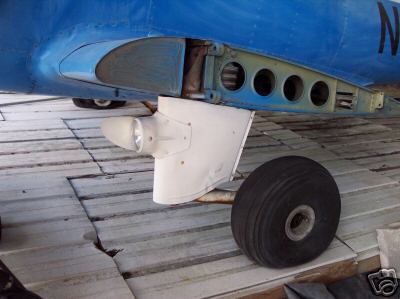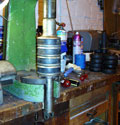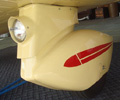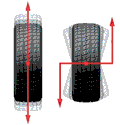The landing gear
Landing Gear Discussion (Univair)
Nose wheel bearings:
Bearing cone number is 08125 same as aircraft spruce #214-00400
Cup number is 08231 same as aircraft spruce #214-00300
These same bearing cone and cups are used in the 700 x 4 Hayes/Goodrich 800 x 4 MLG wheel & drum assembly (shown in the Ercoupe Parts Catalog, P. 12, Fig. 11, Nos. 14a & 14b for serials 113-812). Each such wheel assembly requires 2 cones and 2 cups per wheel.
These same bearing cone and cups are used in the Cleveland 5.00 x 5 21-100D wheel are shown on p. 21 the Ercoupe Parts Catalog. This wheel requires 2 cones and 2 cups per wheel.
My information on the Goodyear 5.00 x 5 nose wheel is that it, too, uses the above bearings.
Servicing:
The original nose gear had no seals (to speak of) and called for DOT
3 brake fluid, as did the Hayes brakes and the main gear oleos with cup
seals. Subsequently, the lower bushing of the outer nose wheel strut has been modified to include an
o-ring seal and the fluid recommendation changed to MIL-5606 hydraulic
fluid. After SN 812 the main gear oleos were changed to o-ring seals
and the brakes to Goodyears, so all fluid recommendations were then
MIL-5606.
When reverting to the better sealing cup in the main oleos, Dot 3 brake fluid was the logical choice of hydraulic fluid again.
Links:
http://www.groveaircraft.com/axlehardware.html
Brakes
Ercoupe Cleveland Wheel and Brake Conversion Kit
Model/Name: ERCO E, G, 415-C, 415-D & 415-CD (S/N 813 & up) FORNEY F-1, F-1A
Kit Number: 199-69
Tire Size: 6.00-6
Main Wheel Assembly: 40-41
Standard Disc: 164-00300
Chrome Disc: N/A
Brake Assembly: 30-30
Lining Type: 066-10500
Comments: Installation per FAA STC SA120GL, SA127GL.
Failure reports on Brake parts
Univar: 415-C; Sheared Brake Clevis; ATA 3240
"On landing," says this general aviation technician, "(this aircraft) lost braking action. An investigation found the brake piston clevis rod between the brake pedal arm and the master cylinder had sheared below the lock nut." (Piston clevis rod P/N: 4008. Component name and P/N: Brake Arm; 41533458. See photo below.)

About Oleos
The oleos are intended to absorb the shock of stabilized descent touchdowns. That's why there is approximately a foot of travel for both mains and nose gear oleos by design. As a result, the coupe can be stabilized for a 500 fpm descent in the approach and touch down at that rate without damage presuming properly serviced and fully functional oleos and donuts that are not too old and hard or Belleville springs that have none broken in the stacks. When an aircraft is flown with non-functioning oleos, landing shocks are transmitted directly to aircraft structure (think "banging" noises and eventual spar, etc. cracks).
The Bellevilles and donuts are "taxi springs" for the main gear (the nose gear has one internally). They absorb presumably minor shocks to the aircraft landing gear and the spar it is mounted on when the aircraft is in motion on the ground.
For proper aircraft control and operation it is essential that with either Bellevilles or donuts that when the aircraft is static on level ground that the sills to each side of the cockpit be reasonably level. This can be easily checked with a carpenter's level (from side to side) and with a "torpedo" level (short, 6" or so long) longitudinally on each side.
Your rubber donuts have been on the plane for 3-1/2 years. I highly suspect they are at or near the end of their useful life, having compressed considerably and are likely now quite hard with little, if any, residual "compressibility" in operation. Jack up one side of the plane to take the weight off the MLG on that side and check the donut "stack" for free movement up and down. You shouldn't have any when donuts are new, and the more you have, the lower your tail will set and the less "squish" your rubber has to absorb taxi shocks. The donuts do not "age" so much in terms of "time since manufacture" (although I have seen some "NOS", new old stock, that are almost incompressible even though never installed), as from "time in service"...the weight of the aircraft on them all the while the plane is on the ground after instalation.
Bellevilles don't compress in normal service. They are expensive (as a retrofit) and do require specific periodic service for maximum operational life and efficiency. As Lynn pointed out yesterday, the stack of seven units, plus spacers on each side should be disassembled at each annual, each spring unit lubricated and greased and the AN27-25 mounting bolts at top and bottom of each oleo greased before reassembly. If the assembled stack is loose, disassemble and insert spacers until all slack is gone and units do not rotate easily. There should be some pressure required to reinstall the snap ring.
In my opinion the Bellevilles are a "pay me now or pay me later" proposition. They do the job intended just about indefinitely when properly serviced. They are an expensive retrofit (Univair SK-35 or Skyport SMK 115), but replacing donuts every three years or so is not without expense (and tail height is not constant in between).
William R. Bayne












